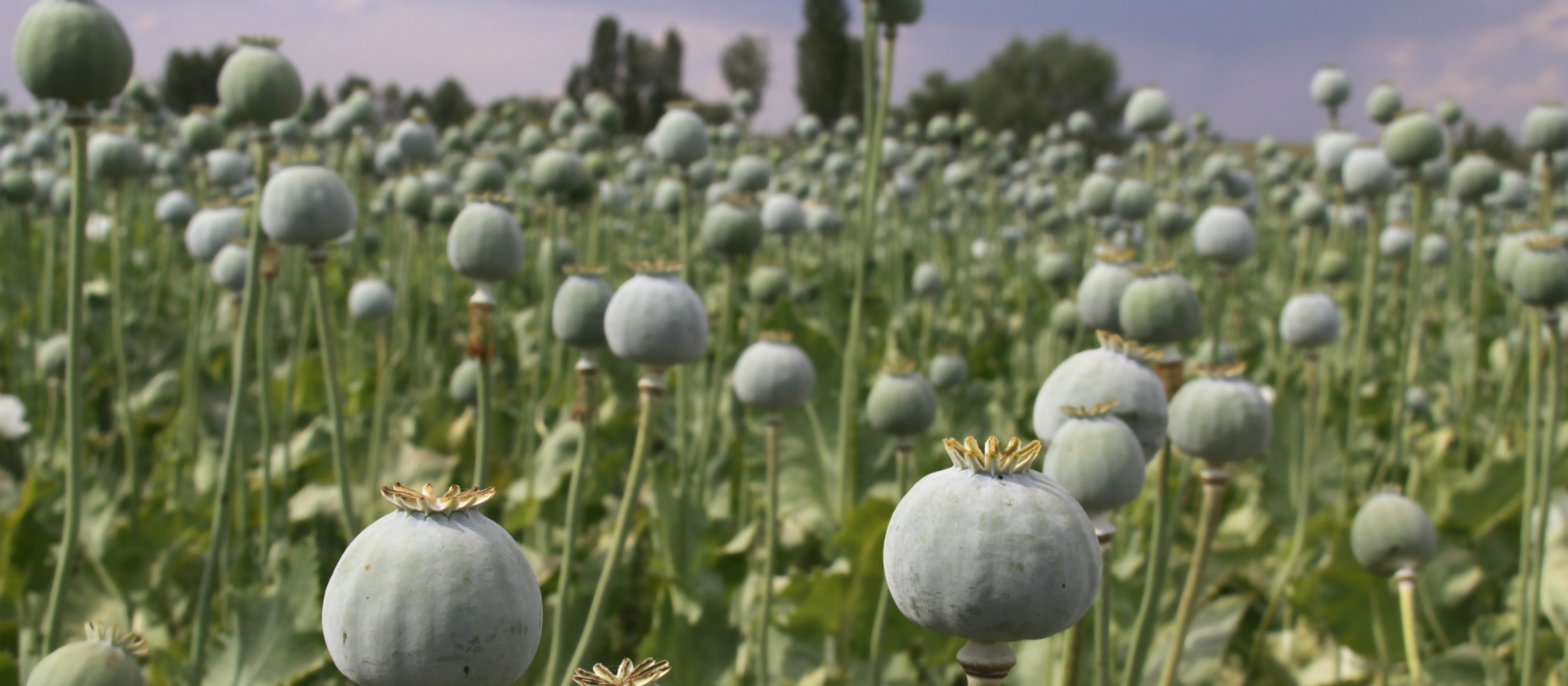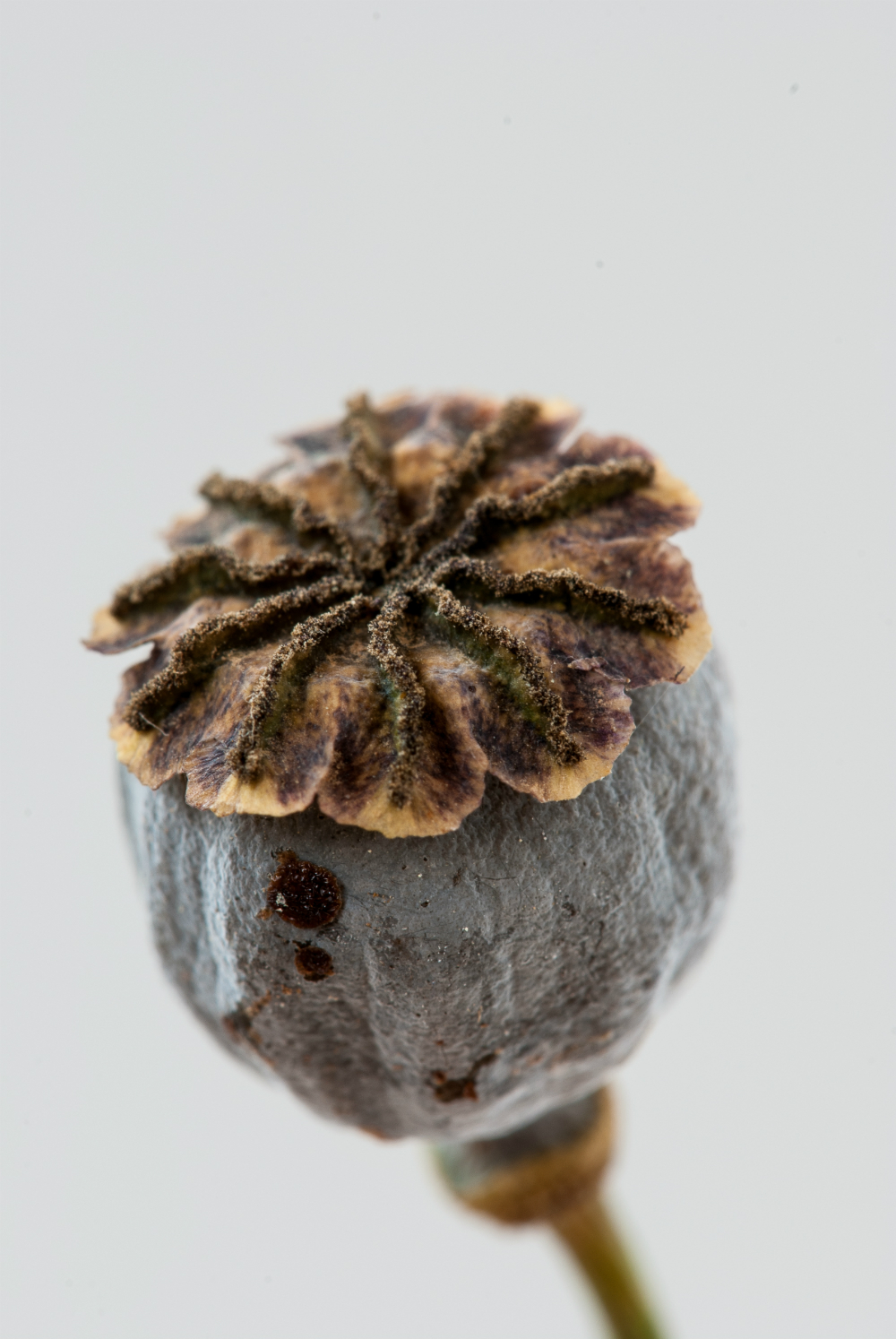- The value of opium poppy resides in the alkaloids contained in the plant’s bulb.
- The milky fluid that exudes from the capsule of poppies is the main source of morphine and heroin.
- From its origins and growing areas to its medical applications, we give you the lowdown on this intriguing plant.

Known under many names including breadseed poppy and Papaver somniferum, opium poppy is a beautiful plant that can have flowers in many shades of red, purple and white. These are held on a stem covered in leaves that culminates in a capsule topped with a star-shaped 'lid' containing opium, which is used for producing morphine, codeine and heroin, amongst others. The reason for the fuss surrounding the plant is in the alkaloids it produces, the active compounds that give patients some solace when no other substance seems to work but that also enslave those who try them, who go back to them again and again seeking the peace of mind they fail to find elsewhere.
Curative and lethal, loved and criticised, opium poppy is the queen of all flowers, the source of the opium used for producing pain relievers and heroin alike.
Description of opium poppy
Breadseed or opium poppy is an annual herbaceous plant - i.e. it completes its life cycle within a year - that germinates in spring growing up to one metre tall. It produces plenty of leaves that clasp the upright stem and flowers around may, marking the beginning of summer with flowers that seem to float in the air - when the green fields become dotted with hues of red or purple is a clear sign that the sunny season is around the corner. Of undisputed beauty, in some countries it is grown for ornamental rather than for sedative purposes, as its appealing shapes and colours are well worth the effort of applying for the necessary license.
Substances including morphine and codeine are derived from alkaloids
Actually, the seeds are legal in places like Europe and the United States, as strictly speaking, the alkaloids are not found in the seeds and are not produced until the flower reaches maturity - only adult plants are able to produce alkaloids such as morphine, codeine, thebaine and narcotine. The scientific name of the plant, Papaver Somniferum, is of Latin origin and derives from the word somnia, which means 'sleep'. The word 'opium', instead, which refers to the plant's sap, is of Greek origin and means 'juice'.
Opium, however, is not found in the flower but in the fruit, a spherical capsule topped with a stellate circumference that exudes the whitish, sticky juice containing the alkaloids when the outer crust is cracked. This milky juice or latex turns brown on contact with the air and is known as raw opium.
Origins of opium poppy

Opium poppy originates from South Eastern Europe and Western Asia, presumably from the western Mediterranean basin, from where it was exported around the world owing to its crucial role in the production of morphine from the 19th century on. That said, there are references to opium poppy in texts dating from periods as diverse as Ancient Egypt, Ancient Greece - again, the word opium derives from ancient Greek - the Roman Empire and our days.
Nowadays, the plant is grown in warm, temperate climates, with production having traditionally been dominated by Afghanistan, mainly with illegal crops grown for heroin, as has been revealed in multiple specialised articles.
Although less well-known, another major producer is Spain, where opium poppy is grown legally for pharmaceutical use. According to an article by Spanish newspaper El País, in 2016 alone Alcaliber cultivated 13,000 hectares of thebaine-rich strains - a strong pain-relieving substance - second only to Australia.
More controversial is the case of the southern Mexican state of Guerrero, making the headlines recently for its many illegal plantations of opium poppy grown for heroin.
Benefits
Opioids and the effects they have on the body are the main reason for the buzz surrounding opium poppy, with morphine and codeine emerging as the most widely used in medicine. But how do they affect the body? Why do these alkaloids make us react the way we do? What are their side effects? Well, let's take a step back and look at one thing at a time.
What are alkaloids
Alkaloids are nitrogenous organic compounds of plant origin including morphine and cocaine, as well as softer versions such as caffeine and nicotine. The first scientist to ever isolate an alkaloid was Friedrich Sertürner, a German chemist and pharmacist who isolated morphine in the early 19th century. The alkaloids found in opium poppy are extracted from the bulb.
What are the effects of opioids
Opium poppy stands out for its sedative effect: opioids have no match when it comes to reducing pain, neutralising it completely depending on the dose.
Why opioids have sedative properties
According to the National Institute on Drug Abuse (USA), plant opioids bind to proteins known as opioid receptors in the brain, bone marrow, gastrointestinal tract and other organs, systematically reducing pain perception.
Side effects of opioids
Opioids are associated with somnolence, constipation and, depending on the dosage, also with respiratory depression. According to the NIDA, they may also produce a euphoric effect in some people, as they interact with brain regions associated with reward processing. This alone may not seem particularly worrying, but it cannot be overlooked that in October 2016 the US declared a state of public health emergency because of the high mortality rate associated with opioids.
A 2014 report by the World Health Organization was blunt: 69,000 people die from opioid overdose worldwide each year. Because opioids interact with the part of the brain that controls respiration, the substance can cause respiratory depression and even death. And yet the most harmful side effect of opioids is substance dependence, a process closely linked to substance tolerance.



Comments from our readers
There are no comments yet. Would you like to be the first?
Leave a comment!Did you like this post?
Your opinion about our seeds is very important to us and can help other users a lot (your email address won't be made public).